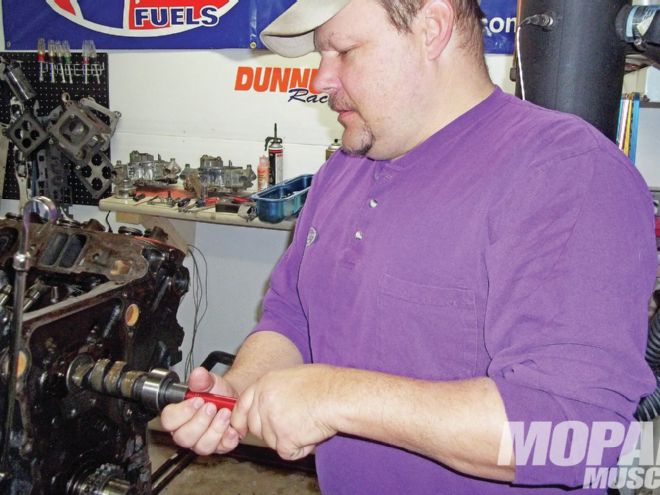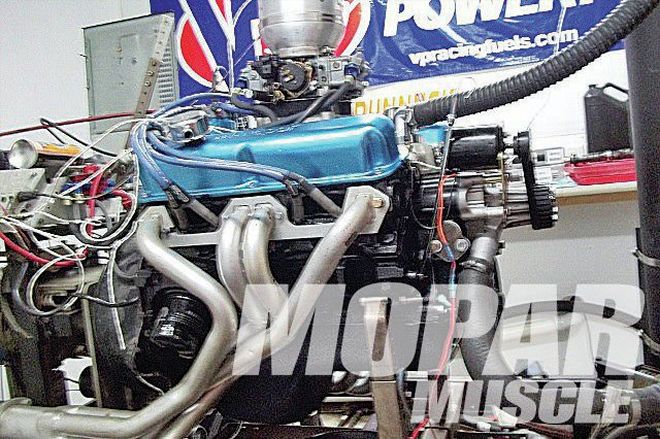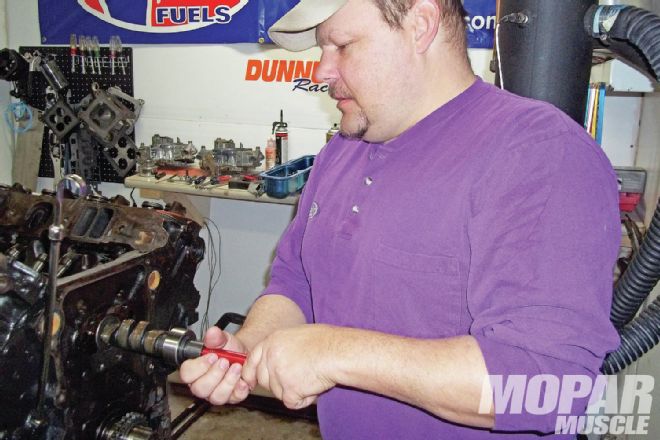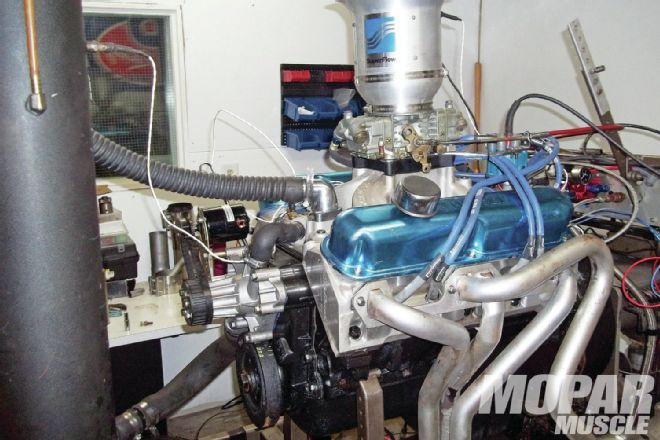
In the search for more power from our engines, we usually start with simple bolt-ons, such as intake manifolds, exhaust headers, and carburetor and ignition upgrades. But when we reach practical limits with such bolt-on items, we need to start getting deeper inside the engine, whether it is a camshaft, cylinder heads, or some other such modification.
Over most other components, the correct performance camshaft can make the biggest improvement in an engine. If you look through a camshaft catalog or website to choose a new camshaft, you will often see several choices for a given engine family that are all designed to function in the same given rpm range. Competition Cams has several choices for most applications, so we decided to test a few of their camshafts in a mild street engine we had on hand, and see how different camshaft designs chosen for the same engine and its appropriate rpm range would perform.
This engine resembles a basic street piece that many enthusiasts have put together in their driveway over the years. We used a late ’70s 360 with stock internals that is topped off with a set of J heads with 1.88-inch valves. The measured compression ratio came out to 8.8:1. We used an M1 dual-plane intake, mated to a Holley 670 Street Avenger vacuum secondary carburetor. The burnt fuel was routed through a set of 15⁄8-inch Hooker street headers.
Our camshafts ranged from a mild 268AH-10 split-pattern muscle car grind, to a Magnum 270 grind that has a single pattern, and finally a newer Thumper grind, number 279TH7, that is aimed at providing a “thumping” idle that will get noticed at the local cruise night, and still be able to perform. All three of these choices were chosen due to matching up with the rest of our engines’ parts we had chosen to run in the 1,800-5,800-rpm range.
We started our tests with the 268 camshaft. This camshaft features an advertised duration of 268 degrees on the intake side, 276 degrees on the exhaust side. The at .050-inch duration is 222 intake, and 226 exhaust with nominal lift figures of .464-inch on both lobes, and a lobe separation of 110 degrees. We installed this camshaft with the intake lobe at 106 degrees. After the initial break in and leak checks were performed, we set the idle to 850 rpm and recorded the engine vacuum for comparison later. The dyno’s vacuum gauge showed 9.5 inches. We also noticed just enough of a performance idle to know all was not stock. After a few easy pulls to dial in the ignition timing and check the air/fuel mixture, we set the dyno’s load control to make a sweep from 1,800 to 5,800 rpm. The engine responded with a nice torque curve, and produced relatively decent horsepower for the compression ratio involved. The peaks of 363.3 lb-ft of torque at 2,900 rpm, and 301.3 horsepower at 5,300 rpm are pretty comparable to several crate engines on the market using similar combinations, so we felt we would not see huge gains within our test range.
 1. We started out with a basic low-mileage 360 that we salvaged from a van chassis motorhome. The short block was built in 1977, but the heads were small-valve J heads from the early ’70s. We topped it off with a used Mopar Performance dual-plane intake manifold and a Holley 670 Street Avenger vacuum secondary carburetor.
1. We started out with a basic low-mileage 360 that we salvaged from a van chassis motorhome. The short block was built in 1977, but the heads were small-valve J heads from the early ’70s. We topped it off with a used Mopar Performance dual-plane intake manifold and a Holley 670 Street Avenger vacuum secondary carburetor.
 2. We started our testing by installing the Competition Cams 268-AH grind, which according to the catalog is designed as a modern replacement for a factory 340 High Performance engine. Comp also states that this grind is best suited for an rpm range of 1,800 to 5,800.
2. We started our testing by installing the Competition Cams 268-AH grind, which according to the catalog is designed as a modern replacement for a factory 340 High Performance engine. Comp also states that this grind is best suited for an rpm range of 1,800 to 5,800.
 3. After a thorough break-in procedure on the Superflow dyno, we put the 360 through jetting and timing loops to get the tune correct. With 34 degrees of total timing being optimum, and the jetting in our 670 Holley needing only a slight increase in jets to be perfect with the local 87-Octane pump gas.
3. After a thorough break-in procedure on the Superflow dyno, we put the 360 through jetting and timing loops to get the tune correct. With 34 degrees of total timing being optimum, and the jetting in our 670 Holley needing only a slight increase in jets to be perfect with the local 87-Octane pump gas.
The next camshaft to be tested was the Magnum 270.This camshaft features an advertised duration of 270 degrees on both lobes, and duration at .050 inch of 224 degrees. The lift figures for this camshaft were .470-inch, and it also has a lobe separation of 110 degrees installed at 106 degrees. After the same initial start-up procedures were done, we made our test pulls again, and were rewarded with 365.9 lb-ft of torque at 2,900 rpm, and 306.8 horsepower at 5,100 rpm. The idle quality at 850 rpm was not significantly different as was confirmed by the similar vacuum reading of 9.25 inches.
We then moved on to the Thumper cam, which looks quite a bit larger in regards of duration on paper, but is still rated for the same basic rpm range. This camshaft features an advertised duration of 279 degrees on the intake, and 296 degrees on the exhaust. The .050-inch duration was 227 degrees on the intake, and 241 degrees on the exhaust. The lift was also split with this camshaft, with nominal figures of .486-inch on the intake and .473 inch on the exhaust. The larger exhaust duration combined with the narrower lobe separation of 107 degrees is where the radical exhaust sound comes from. We installed this cam with the intake at 102 degrees, per Comp Cams’ recommendation. After the break in period was completed and the idle speed was set, we could tell that this engine definitely had some “bark” to the idle, as compared to what we had previously heard. The vacuum at 850 rpm did drop to 8.25 inches. The power numbers we received with the Thumper cam were a little surprising. Even though the torque was similar to the Magnum camshaft through the middle of the rpm range, we were pleased to see a new best of 370.2 lb-ft at 27,-2,800 rpm. We have heard from numerous sources that a narrower lobe separation makes for a narrower torque curve, but we saw a wider curve during this test. We also saw a new best at the upper end of the test range, recording 325.1 horsepower at 5,400 rpm.
Hopefully this gives some insight as to how some of these differences in camshafts can affect an engine. We hope to squeeze a little more power out of this engine with some other changes at a later date, but feel that even at this level, the power is pretty respectable for a low compression “smog” engine.
PRICE TAG PN 20-309-4 $144.99 PN 20-214-4 $144.99 PN 20-600-4 $144.99 Comp Lifters PN 822-16 (3 sets at $85.95 ) $257.85 Oil, filters, gaskets, misc stuff $89.45Contacts
Dunnuck Racing Enterprise
[email protected]